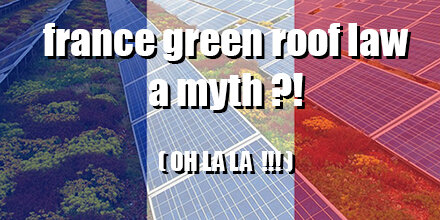France’s Famous Eco-Roof Law – Too Green To Be True?
Table of Contents Show
The Viral News That Wasn't
In early 2015, the online community was enamoured by a new law that supposedly mandated commercial development projects in France to be partially covered by plants or solar panels. One article from The Guardian posted March 2015, “France decrees new rooftops must be covered in plants or solar panels,” has alone been shared on Facebook over 348,000 times. (For reference, articles on The Guardian are shared an average 1,080 times, according to a study by online content insights provider Buzzsumo.) Almost a full year later, urbanstrong staff are still receiving forwards of this ‘too good to be true’ piece of news.
France’s Biodiversity Strategy and the Birth of Article 36
Sadly though, for fans of green infrastructure and renewables alike, this news is more wishful thinking than reality, for now.
French flag overlaid with rooftop solar panels and green vegetation, representing France’s proposed eco-roof law.
Backed by French environmentalists and born out of France’s National Biodiversity Strategy, the proposed law had potential to push the nation into the next phase of sustainability. The idea received applause across social media, blogs, and green news websites. From reducing stormwater runoff, providing energy efficiency, wildlife habitat, and minimizing the urban heat island effect, the reasons to be excited about green roofs were clear. However, many of those who reported on the topic failed to realize that the law was never actually passed. This left the world believing that rooftop gardens were about to start springing up across France, when in reality, while it may one day be a law, for now it’s merely an idea.
During the 1992 Rio Earth Summit, France signed the Biological Diversity treaty, an international effort to develop strategies for the conservation and sustainable use of biological diversity. In 2010 the Nagoya Protocol was adopted; an action plan for preserving biodiversity through 2020. By 2011, France developed its National Biodiversity Strategy, and the green roof policy was one of its results. Its roots therefore reach back to the early 1990s.
Why the Green Roof Law Was Rejected
In 2015, these long standing efforts appeared to be coming to fruition. The biodiversity initiative that aimed to make France a nation of excellence for green and blue development was under review. At the time, 564 propositions were examined, and then sent back with 225 amendments. The green roof policy (Article 36), although popularized, was merely one proposal among hundreds, and along with many others, was ultimately struck down.
The requirement to install green roofs or solar panels in France was thus deleted. The French green roof industry, ADIVET, is currently lobbying to revive Article 36, but it faces opposition from the commercial industry. Building owners are refusing to bear the additional construction expenses, threatening to simply pass them along onto consumers if the policy is passed. The proposed green roof policy therefore remains a project at this point.
The Solar + Green Roof Synergy
Originally the policy solely mandated green roofs, but then morphed to include the option of installing solar panels instead. This amendment has sparked discussion amongst those few who understand that solar arrays and green roof systems aren’t mutually exclusive. Contrary to their usual rivalry in the marketplace, the two technologies don’t necessarily have to compete for photons or rooftop real estate; they can actually be configured to work together synergistically.
When used in conjunction, solar and green roof systems boost each other’s performance. The evapotranspirative effects of the green roof plants cool the air beneath the panels, reducing their efficiency loss due to overheating. Compared to a solar pv system installed on a traditional rooftop, this results in a 10-18% boost in electricity production which goes straight to the bottom line. This additional output of the solar array dramatically boosts the ROI of the whole system, paying for itself many times over. Meanwhile, the shadows cast by the solar panels foster the growth of more shade-seeking plants thereby increasing the biodiversity of the system. Learn more about Integrated Solar-Green Roofs
City vs. National: Global Green Roof Policies
Around the globe, cities are working to become more sustainable through green, white, and blue roofs, solar and wind energy, and an array of carbon offsetting incentives. What’s unique about the French law is that it is not isolated to Paris or Lyon, but rather the whole nation. So far, laws like these only encompass one city at a time. This bears the question: Is it more effective to approach the green movement in localized programs or from the top down? Here’s what’s happening in cities around the world now:
Toronto
In May 2009, Toronto became the first city in North America to mandate green roofs on all new developments, including residential, commercial and institutional (with a minimum Gross Floor Area of 2,000m2 / 21,530ft2). The city’s initiative is a success story, with 260 green roofs and 196,000m2 / 2,110,000ft2 of green roof area created since 2010. In fact, according to the Green Roofs for Healthy Cities’ ‘Annual Green Roof Industry Survey,’ Toronto took the #2 spot, just behind Washington DC, for the most square feet of green roofs installed in 2014.
Copenhagen & Zurich
Copenhagen became the first Scandinavian city to adopt a policy requiring all new development with roof slopes of 30% or less to be green. The same law has also been adopted in Zurich.
Tokyo
In 2001, Tokyo mandated new buildings 1,000m2 / 10,760ft2 or larger be covered by at least 20% of greenery.
Instead of mandating green roofs, many municipalities in the U.S. offer a range of incentives to encourage vegetation over other roofing options.
Baltimore
In the city of Baltimore, the not-for-profit Blue Water Baltimore, offers a green roof incentive of $2 per square foot of green roof installed. Although the municipality itslef does not provide green roof incentives, it does allow green roofs to replace other stormwater management requirements.
Chicago
Chicago consistently ranks in the Top Five for North American metro regions with the greatest area of green roof installations per year. In the past, the city offered to cover up to 50% of the installation cost for green roofs (capped at $100,000). In addition, commercial development projects integrating green technologies receive expedited permits.
Washington, D.C.
Washington, D.C. installed 1.2 million square feet of green roofs in 2014, more than any other North American Metro Region for the fourth year running. The capital offers a robust green roof rebate program, with base funding of $10 per square foot, and up to $15 per square foot in targeted subwatersheds. Amazingly, there is no cap on the project size for these rebates. Green roof sites are also eligible for up to a 55% discount on stormwater fees depending on how much rainfall their roofs mitigate. Additionally, sites that reduce stormwater runoff beyond the minimum requirements can earn credits. These credits can then be sold through an exchange to buildings that are unable to meet requirements. Because of D.C.’s expansive benefit package for green roofs, it’s no surprise that as of November 2015, there were 232,719m2 of green roofs, amounting to 58 acres of rooftop vegetation. http://1.usa.gov/1OcuirZ
New York City
In New York City property tax abatement has increased from $4.50 to $5.23 per square foot of a green roof, up to $200,000 or the total tax liability of the building for the year in which the abatement is taken, whichever is lesser. The application deadline extended to March 15, 2018, for tax years beginning this July 1, and ending June 30, 2019.
The New York City Department of Environmental Protection offers a Green Infrastructure Grant for projects that manage the first 1” of rainfall/stormwater in targeted areas. Projects awarded a grant are reimbursed for 100% of the design and construction costs of green roof projects. Eligible projects include blue roofs, rain gardens, green roofs, porous pavement and rainwater harvesting on private property in combined sewer areas.
Lessons for France and the Path Forward
Regardless of never actually having become a law though, the idea remains a sensation around the globe where it is falsely believed to be an actively implemented policy. Again, to this day, we here at urbanstrong still receive forwards from colleagues and friends either congratulating us, or asking if we’ve yet read the news of this win against grey infrastructure and fossil fuels. If nothing else, the viral sharing of this rumor is an indication of mass public interest and worthiness of further exploration.
Around the world cities are taking steps toward a more sustainable future. From individuals enjoying fresh produce, to the public experiencing less pollutants in their water, and buildings that save on electric bills, it’s clear that investing in green roofs is a wise decision. It’s still up in the air if incentives, as opposed to mandates, ultimately lead to more cities embracing green roofs. In France, business owners want the path of least resistance. To invest their own money in a cost not shared with the government has caused a huge pushback on the green roof law. It seems that France could learn from many success stories throughout the world. Perhaps if the French government adopted a rebate program similar to Washington, D.C., their law would be more widely accepted by various stakeholders. Of course, the French law was not crafted for one city, but rather, a whole nation. If the law does pass, France will pioneer a new frontier of nationwide green roof policy. Only time will tell if this will trump the results found in the current format of city-run programs.


